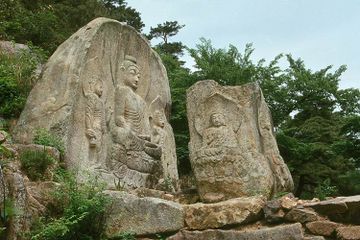경주 남산 칠불암 마애불상군
| 경주 남산 칠불암 마애불상군 Rock-carved Buddhas at Chilburam Hermitage in Namsan Mountain, Gyeongju |
|
 경주 남산 칠불암 마애불상군, 국가문화유산포털, 문화재청. |
|
| 대표명칭 | 경주 남산 칠불암 마애불상군 |
|---|---|
| 영문명칭 | Rock-carved Buddhas at Chilburam Hermitage in Namsan Mountain, Gyeongju |
| 한자 | 慶州 南山 七佛庵 磨崖佛像群 |
| 주소 | 경북 경주시 남산동 산36-4번지 |
| 지정(등록) 종목 | 국보 제312호 |
| 지정(등록)일 | 2009년 9월 2일 |
| 분류 | 유물/불교조각/석조/불상 |
| 시대 | 통일신라 |
| 수량/면적 | 7구 |
| 웹사이트 | 경주 남산 칠불암 마애불상군, 국가문화유산포털, 문화재청. |
|
|
|
해설문
국문
동쪽을 향한 넓은 바위 면에 삼존상이 있고, 삼존상 바로 앞 네모난 돌기둥에는 면마다 불좌상을 새겼다. 삼존상의 본존과 두 보살, 그리고 돌기둥의 사방불(四方佛)을 합쳐 모두 7구의 불상을 새겨져 있어 칠불암이라 불리고 있지만, 원래 사찰 이름은 알 수 없다.
이 마애불상군의 중심은 삼존불 중앙의 불좌상이다. 오른쪽 어깨를 드러낸 가사(袈裟)를 걸치고 오른손을 무릎에 얹어 손가락으로 땅을 가리키는 항마촉지인(降魔觸地印)*을 하였다. 사방불은 방향에 따라 각기 다른 손모양을 하고 있는데, 정면이 되는 동쪽면의 불상은 약그릇을 지니고 있어 약사불임을 알 수 있다.
마애삼존상 뒤편에 뚫린 여러 개의 구멍과 돌기둥 위에 파인 홈, 그리고 기와조각들이 흩어져 있는 것으로 보아 원래는 석굴 사원처럼 위에 지붕을 덮었을 것으로 추정된다.
주변에서 『약사경(藥師經)』과 『금강경(金剛經)』을 돌에 새긴 석경(石經) 파편들이 발견되어 약사신앙과 관련된 사찰로 추정되며, 석불의 제작 시기는 석굴암 본존보다 앞설 것으로 보고 있다.
- 항마촉지인(降魔觸地印) : 좌선할 때의 손 모양에서 오른손을 풀어서 오른쪽 무릎에 얹고 손가락으로 땅을 가리키는 손 모양으로, 석가모니가 수행을 방해하는 모든 악마를 항복시키고 성취한 정각(正覺)을, 지신(地神)이 증명하였음을 상징함.
영문
Rock-carved Buddhas at Chilburam Hermitage in Namsan Mountain, Gyeongju
These rock carvings, located near the top of Bonghwagol Valley on Namsan Mountain, depict a Buddhist triad and the Buddhas of the Four Directions. They are presumed to date to the mid-8th century at the height of the Unified Silla period (668-935).
The Buddhist triad, which consists of a principal buddha flanked by two attendant bodhisattvas, is carved on a large rounded boulder. In front of this is a smaller rectangular boulder with one of the Buddhas of the Four Directions carved on each side. All of the figures are depicted atop a lotus pedestal with a halo behind their heads. The five buddhas are seated and are each depicted with a different symbolic hand gesture. The two bodhisattvas stand facing the principal buddha and hold a flower stem and a bottle of pure water, respectively.
Because there are a total of seven figures depicted here, the nearby Buddhist hermitage was named Chilburam, meaning “Hermitage of the Seven Buddhas.”
- The buddha on the front holds a medicine bowl, indicating that it is a depiction of Bhaishajyaguru (Medicine Buddha).
- , who is believed to possess the power to heal illness and physical defects
- In the vicinity, stone plates inscribed with the Sutra of the Medicine Buddha and the Diamond Sutra were found, suggesting that there was once a temple here which worshiped Bhaishajyaguru. However, the name of this temple is unknown.
- Based on various remains, such as holes carved into the rocks, shards of roof tiles, and the aforementioned stone plates, it is thought that these carvings were once covered with a roofed grotto made with stone-plated walls. These carvings are thought to be related to Seokguram Grotto (National Treasure No. 24) and the Stone Buddhas in Four Directions at Gulbulsa Temple Site (Treasure No. 121).
- The right hand of the Buddha reaches down toward the ground, and his left hand rests on his lap, indicating his defeat of worldly desires and his attainment of spiritual enlightenment.
- The one on the rear is presumed to be Amitabha (Buddha of the Western Paradise).
- 칠불암은 언제 건립했는지...
- 사방불의 묘사가 조금 달라요~ **민백 : 서면상(西面像)은 동면상과, 북면상(北面像)은 남면상과 서로 유사하나, 북면상은 다른 세 불상과 달리 특히 얼굴이 작고 갸름하여 수척한 인상을 주는 것이 특징이다.
- 불상이 7개인데 이런 해설문이 조금 길 수 밖에 없는 것 같아요. 국문에 포함한 내용 (특히 불상 묘사)가 좀.... random한 느낌이 들어요.